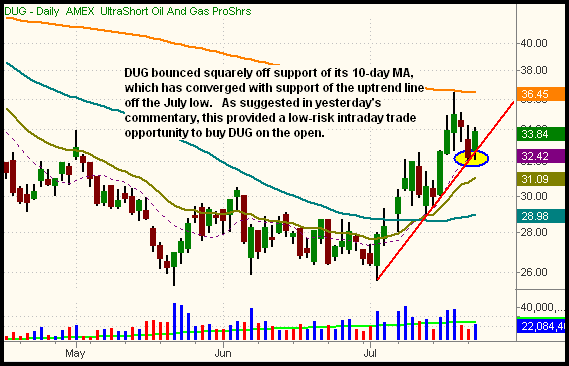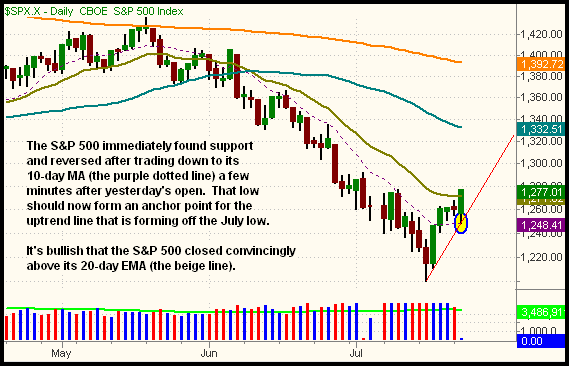|
The Wagner Daily ETF Report For July 23
After opening substantially lower, it initially looked as though the major indices were headed for another day of range-bound, indecisive action, but a late-day rally enabled stocks to reverse early losses and finish much higher. The Nasdaq Composite began the day with a 1.1% loss, then closed the session with a 1.1% gain. The S&P 500 and Dow Jones Industrial Average followed similar intraday patterns before climbing 1.4% and 1.2% respectively. Relative strength in small-cap stocks, which we pointed out in yesterday's commentary, became glaringly apparent today, as the Russell 2000 motored 2.8% higher. The S&P Midcap 400 advanced 1.3%. All the main stock market indexes closed convincingly at their best levels of the day.
Sharply higher volume accompanied yesterday's gains, enabling both the S&P 500 and Nasdaq Composite to score their second "accumulation day" within the past four sessions. Total volume in the NYSE surged 31%, while volume in the Nasdaq rocketed 40% above the previous day's level. On July 17, two days after the broad market formed its recent bottom, stocks gained on increasing volume. Over the next two days, while the main stock market indexes consolidated in a sideways range, volume declined. Then, as stocks resumed their recent bullishness yesterday, higher turnover again matched the gains. This is precisely the type of volume pattern stocks exhibit in healthy markets. Based purely on the recent buying by mutual funds, hedge funds, and other institutions over the past week (the two "accumulation days"), it appears overall sentiment in the market is changing (at least for the near-term).
Yesterday, we illustrated how UltraShort Oil & Gas ProShares (DUG) had pulled back to support of both its 10-day moving average (MA) and its intermediate-term uptrend line. As anticipated, the 10-day MA "did its thing" by prompting DUG to resume the direction of its relatively newly established uptrend. Although DUG performed as expected, we passed on "officially" buying it as a new ETF trade. Upon further analysis of the oil and oil service sector charts, we came to the conclusion that DUG was more likely to chop around in a range in the near-term, rather than actually resume its uptrend. Nevertheless, DUG presented a low-risk intraday trade for traders who followed our idea to buy yesterday's open. The bounce off the 10-day MA is shown on the daily chart below:

While on the subject of pullbacks to the 10-day MA, you may find it interesting to know that yesterday morning's low in the S&P 500 coincided with a touch of its 10-day MA as well. The touch of the 10-day MA in the morning immediately resulted in price support that subsequently led to the late-afternoon rally. By day's end, the S&P 500 had broken out above the high of its recent range and its 20-day exponential moving average (EMA). Yesterday's low in the S&P 500 (the touch of the 10-day MA) should now become an anchor point for the lower channel of the uptrend that is now forming off the July low. The anchor point on the new uptrend line is circled in blue on the chart of the S&P 500 below:

In the July 18, 2008 issue of The Wagner Daily (last Friday), we illustrated resistance levels the S&P 500 would likely encounter in the near-term. With regard to the 20-day EMA of the S&P 500, we said, "The next resistance level the S&P 500 will soon encounter is the 20-day exponential moving average (EMA). . .because the May - July downtrend was so intense, a bounce to the 20-day EMA does not even represent a 38.2% Fibonacci retracement for the S&P 500. As such, pure momentum of the current rally should at least enable the S&P 500 to test its 20-day EMA sometime next week." As shown on the chart above, our expected test of the 20-day EMA indeed happened "sometime next week."
In that same commentary, we also suggested that a rally into the 20-day EMA would be a good place to take profits on long positions that were bought near the lows, or at least tighten stops to lock in gains. However, because the stock market had a few days of low volume consolidation after the initial rally, as well as two days of higher volume gains, we now think the major indices are not in great danger of quickly rolling back over (at least for the next several weeks). Still, with so much supply and numerous resistance levels looming overhead, it would be foolish to suddenly throw caution to the wind and begin aggressive buying operations.
Yesterday, we expressed concern over the fact that disappointing earnings guidance from Apple Computer (AAPL) caused its stock to tumble 10% in after-hours trading. This was only a concern because Apple is such a keystone, leading stock within the Nasdaq. But to the delight of iPod and Mac fans around the globe, Apple actually turned in a great performance yesterday! AAPL opened 10.5% lower, immediately found support, then begin trending steadily higher all day. By the closing bell, AAPL finished only 2.5% lower. Whether you care about AAPL stock or not, yesterday's resilience was an important sign for overall market sentiment. When stocks bounce back from bad news so quickly, it is another sign that the general bias is changing in favor of the bulls. In the near-term, we're now comfortable with conservatively buying stocks and ETFs with relative strength and/or bullish chart patterns. Just don't lose sight of the fact that the main stock market indexes remain well entrenched in long-term downtrends. Until price action proves otherwise, we must still assume current strength in the broad market is nothing more than a counter-trend bounce of a dominant downtrend.
Open ETF positions:
Long - EWH, GLD, RSX
Short - (none)
Deron Wagner is the Founder and Head Trader of both Morpheus Capital LP, a U.S. hedge fund, and Morpheus Trading Group, a trader education firm launched in 2001 that provides daily technical analysis of the leading ETFs and stocks. For a free trial to the full version of The Wagner Daily or to learn about Wagner's other services, visit MorpheusTrading.com or send an e-mail to deron@morpheustrading.com.
|